i. online single arm measurements (by Tanja Horn) 4.2 GeV, 5.2 GeV, 3.8 GeV, 4.7 GeV
To summarize, these results provided a rough online confirmation of the beam energy, HMS momentum, and HMS scattering angle. However, one or two settings have problems at 4.2 GeV, the beam energy or HMS momentum is systematically incorrect at 5.2 GeV, and a few settings have serious problems at 3.7 GeV. Happily, 4.7 GeV looks great. I don't know if these runs were all replayed with good time-to-distance maps. The reported W vs xpfp correlation in the HMS presumably means that the delta offset will be goofy for delta .neq. 0. (This is not obvious, but due to the correlation of xpfp with delta.)
ii. coincidence measurements (aka HEEPCHECK)
Preliminary PmOOP analysis (by Chuncheng Xu)
4.2 GeV (not available yet), 5.2 GeV (not available yet), 3.8 GeV (not available yet), 4.7 GeV (not available yet)
List of HEEPcheck runs (by Chuncheng Xu)
 When the residuals are at the 1 MeV level, the final step in the offset determinations will be
to use simc to determine the apparent offsets caused trivially by electron radiation. As shown
in the figure, electron radiation causes the HEEPcheck variables W, Emiss, Pmpar, and Pmperp to
have tails which can potentially bias the fitted centroid at the 1 MeV level. The only variable
without such a bias appears to be PmOOP.
When the residuals are at the 1 MeV level, the final step in the offset determinations will be
to use simc to determine the apparent offsets caused trivially by electron radiation. As shown
in the figure, electron radiation causes the HEEPcheck variables W, Emiss, Pmpar, and Pmperp to
have tails which can potentially bias the fitted centroid at the 1 MeV level. The only variable
without such a bias appears to be PmOOP.